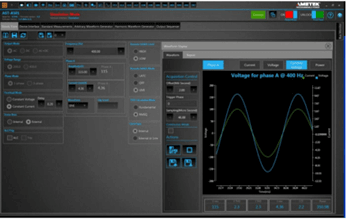Programmable AC Sources Add Features to Expand Purchasing Options
Programmable AC Sources Add Features to Expand Purchasing Options
Programmable AC sources are evolving as their performance increases. If you are in the market for an AC source for the first time in the past 10 years, you will notice some changes.
Modern AC sources offer higher power densities. Overall, they can provide flexibility in power, current, and voltage ratings, which helps you future-proof your test systems to meet changing requirements.
Power density is a key aspect to consider if you are looking for an AC source and want to put it in a rack. In addition, applications are emerging for very high-power AC sources. High-power models have regenerative and electronic-load capabilities in many applications, including renewable-energy tests. Modern sources offer emulation capabilities that mimic the legacy sources’ operation to smooth the transition from legacy sources.
Energy-density improvements highlight AC sources
Exemplifying the features now available on AC sources is the California Instruments Asterion AC product lineup. Versions are available in 1U, 2U, 4U, and 14U chassis, offering output ratings from 500 VA to 18,000 VA; 14U versions can be paralleled for 36,000 VA.
A 4U version, the Model AST6003, demonstrates the improved power density of the new sources. It delivers 6,000 VA, compared to the 5,500 VA provided by a legacy source in an 8.71-in.-high (equivalent to 5U) configuration. A quick calculation shows that the AST6003 delivers a power density of 1,500 VA per rack unit vs. 1,100 VA per rack unit for the legacy source: a 36% improvement. In addition, the AST6003 is available with an optional GPIB interface and emulation capability for the legacy source to simplify your system upgrades and minimize the need to update legacy software. The emulation capability allows AST6003 units to be paralleled up to the legacy source’s maximum rating of 33.3 kVA.
AC sources add voltage and current options
The Asterion AC series possesses flexibility in output current and voltage ratings. This series AC plus DC outputs with low and high voltage ranges of 200 or 400 VAC and 250 or 500 VDC. The 2U, 4U and 14U versions can generate single or three-phase outputs. The customer can control all versions from the front panel or remotely using AMETEK Virtual Panels graphical user interface.
Figure 1. Asterion AC sources work with the Virtual Panels user interface.
Output current flexibility is also essential and the Asterion AC series employs AMETEK Programmable Power’s iX2 constant-power capability that allows current to increase as output voltage decreases. As you can see in the figure below, 100% power remains available as the output voltage rolls down from 100% rated voltage to 50% rated voltage, with the current rising from the 100% full-voltage rating to 200%, resulting in a constant-power output characteristic until reaching a plateau at the 200% current level.
Figure 2. The Asterion AC source exhibits a constant-power output characteristic.
AC source power ratings explode
One trend in programmable AC sources is the increasing demand for higher power ratings. Ten years ago, 5 to 10-kVA was considered high power. In today's world, requirements for half a million VA are common, driven partly by the need to test grid-scale renewable-energy equipment. AMETEK's entries in the high-power AC-source range include the California Instruments Sequoia, a full four-quadrant AC source with electronic-load capability, and Tahoe, an economical two-quadrant option for customers not needing four-quadrant operation. Both employ silicon-carbide (SiC) devices to boost switching speeds and improve efficiency.
Both the Sequoia and Tahoe sources come in three form factors: 15 kVA, 22/30/45 kVA, and 90 kVA, all of which can deliver the same power rating in the DC mode. The designs of these series is flexible and power ranges above 1.08 MVA are available. The units scale up easily—as many as six 22/30/45-kVA chassis can be connected in parallel up to a maximum of 270kVA. Twelve 90-kVA units can be connected in parallel for a 1.08-MVA maximum rating. Both Sequoia and Tahoe series' feature 500-µs time resolution for transients. Regenerative versions conform to anti-islanding requirements.
The Sequoia and Tahoe series offer dual-range 0- to 166-V and 0- to 333-V line-to-neutral direct-coupled outputs, corresponding to 287 VAC and 576 VAC line-to-line. An optional output transformer enables higher voltages for use in AC mode only. Custom versions are also available, including higher-power versions with ratings of more than 1.08 MVA.
Reliability plus flexibilityFive-year Warranty
To conclude, AMETEK offers a lengthy five-year standard warranty on most of its power supplies.
We're here to help
Talk to an expert today.
Our friendly team of highly trained specialists will quickly assist you.
We promise to respond within 4 business hours (AEST).
Or you will receive $100 off your next purchase. Read how it works.
Top FAQs
When purchasing a power supply, the first choice to be made is linear supply or switching supply. Linear power supplies offer low ripple and noise specifications and have fast transient behavior. However they are inefficient and generate a lot of heat. They are also quite heavy. As a result most engineers prefer linear power supplies for low power applications. Using switching power supplies is a better choice for higher output power or multichannel applications. They provide higher power density. Switching power supplies are easier to control than linear supplies and cost about the same per channel.
Transient response is a measure of how well a power supply copes with changes in current demand or how well the supply follows the changes in the load impedance. This is an important specification for many applications.
DC output voltage slew rate is a rise or fall time. DC programmable power supplies have output filters that use large capacitors that store a lot of energy. It’s mainly the charge and discharge time of this filter, combined with the current demand of the DUT, which determine a supply’s voltage slew rate. The voltage slew rate is mostly independent of the connected EUT.
Load Regulation is an important specification of programmable power supplies. This means some percent output voltage change from its set-point due to a change in the current demand of the EUT. Normally this effect should be very small, less than 0.01% of set output voltage.
Line regulation specifies the percent change of the DC output voltage or current as a function of AC input line voltage. This specification is important when the input line voltage is not stable.
Stability is a measure of a supply’s long term output voltage or current drift. Stability is primarily specified in parts per million or ppm.
If more output current is required then paralleling power supply outputs is generally the solution. Ametek Programmable Power uses a dedicated control bus to connect its power supplies in parallel. The system configures itself automatically, identifying which unit is the master and which units are the slaves.
If more output voltage is required then connecting power supplies outputs in series is generally the solution. All you have to do is to connect the positive terminal of one supply to the negative of another. The limitation is that when operated in series, there are no master and slave units. Individual power supplies has to be programmed.
DC programmable power supplies typically provide a standard and isolated analog interface. Through the analog interface a supply’s DC output voltage, current and over voltage protection can be set. The control signal can be a voltage signal, a current signal or by connecting a resistor to the analog input.
Many DC programmable power supplies can be configured for either local or remote sensing. For a more accurate output voltage setting, remote sensing should be use. This method compensates for the voltage drop across the leads to the load terminals.

Upgrading to the Asterion power supply system has given us significant more testing capability and flexibility. It has been a wise investment. Thank you for your advice and support.
Margaret Smith
TEST LABORATORY SENIOR ANALYST AT UNIVERSITY OF NSW

Buying the MX45 California Instruments power source has given us enhanced testing capabilities. We have the SNK option, which is a bidirectional sink option. We are now able to simulate all grid conditions in our lab environment up to 45kVA. For me, reliability is important and I’m happy to say that we have been using this device for many years without any issues.
Keith Boydell
RESEARCH FELLOW AT UNIVERSITY OF WOLLONGONG

We have several Sorensen power supplies in our lab and they are the lowest output noise power supply we have experienced. For any critical research project where output noise and line/load regulations are important, we use only Sorensen power supplies.
Annette Eskdale
TEST LABORATORY MANAGER AT MONASH UNIVERSITY
Technical Support
Our experts are all pre-eminent leaders in electrical products who provide excellent support in their areas of expertise.
Technical supportTalk to an expert
Our friendly team are highly trained product experts who really enjoy helping customers find what they need.
call 1300 387 326Enquire by email
We promise to respond within 4 business hours (AEST) or you will receive $100 off your next purchase.
Enquire now

